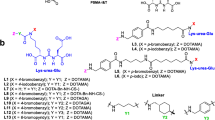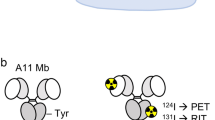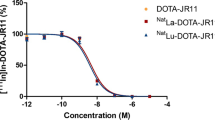Abstract
Objective
We propose an innovative strategy of nanoparticle-mediated-peptide receptor radionuclide therapy (PRRT) employing PLGA-nanoparticles together with anti-β-hCG antibodies that can protect kidneys from radiation damage while simultaneously enhancing its tumor targeting and cytotoxic ability for somatostatin receptor (SSR) positive tumors.
Methods
PEG-coated-177Lu-DOTATATE-PLGA-nanoparticles (PEG-LuD-NP) were formulated and characterized. In vitro toxicity of these particles was tested on human glioblastoma cell line U87MG over a radiation dose range of 19–78 Gy, using MTT assay and flow cytometry. To further enhance cytotoxicity and test the feasibility of active tumor targeting, apoptosis-inducing anti-β-hCG monoclonal antibodies were employed in vitro, after confirming expression of β-hCG on U87MG. In vivo tumor targeting ability of these particles, in comparison to uncoated particles and un-encapsulated 177Lu-DOTATATE, was assessed by intravenous administration in tumor-induced wistar rats. Rats were first imaged in a gamma camera followed by euthanasia for organ extraction and counting in gamma counter.
Results
The particles were spherical in shape with mean diameter of 300 nm. Highest cytotoxicity that could be achieved with PEG-LuD-NP, on radio-resistant U87MG cells, was 35.8 % due to complex cellular response triggered by ionizing radiation. Interestingly, synergistic action of antibodies and PEG-LuD-NP doubled the cytotoxicity (80 %). PEG-LuD-NP showed the highest tumor uptake (4.3 ± 0.46 % ID/g) as compared to 177Lu-DOTATATE (3.5 ± 0.31 %) and uncoated-177Lu-DOTATATE-nanoparticles (3.4 ± 0.35 %) in tumor-inoculated wistar rats (p < 0.001). Renal uptake/retention was decreased 3–4 folds with these particles, resulting in the highest tumor-to-kidney ratio (8.58; p < 0.01) while tumor-to-liver and tumor-to-bone ratios were comparable to un-encapsulated-drug.
Conclusion
Nanocarrier-mediated-PRRT is an effective way of targeting SSR positive tumors for enhanced cytoxicity and reduced renal radiation dose associated with conventional PRRT. To our knowledge of literature, this is the first study to establish in vitro and in vivo efficacy profile of nanoparticles in PRRT providing a stepping-stone for undergoing and future research endeavors in the direction of abating associated radiation concerns of radionuclide therapy and may offer a paradigm shift in PRRT strategy.








Similar content being viewed by others
References
Vegt E, de Jong M, Wetzels JF, Masereeuw R, Melis M, Oyen WJ, et al. Renal toxicity of radiolabeled peptides and antibody fragments: mechanisms, impact on radionuclide therapy, and strategies for prevention. J Nucl Med. 2010;51:1049–58.
Arora G, Shukla J, Ghosh S, Maulik SK, Malhotra A, Bandopadhyaya G. PLGA nanoparticles for peptide receptor radionuclide therapy of neuroendocrine tumors: a novel approach towards reduction of renal radiation dose. PLoS One. 2012;7:e34019.
Talwar GP, Gupta JC, Shankar NV. Immunological approaches against human chorionic gonadotropin for control of fertility and therapy of advanced-stage cancers expressing hCG/subunits. Am J Reprod Immunol. 2011;66:26–39.
Yu N, Xu W, Jiang Z, Cao Q, Chu Y, Xiong S. Inhibition of tumor growth in vitro and in vivo by a monoclonal antibody against human chorionic gonadotropin beta. Immunol Lett. 2007;114:94–102.
Barbieri F, Florio T. Characterization of the differential efficiacy of somatostatin receptor agonists in the inhibition of the growth of experimental gliomas and identification of the intracellular mechanisms involved. Eur J Clin Med Oncol 2011; 3(3): online.
Chen G, Zhu W, Shi D, Lv L, Zhang C, Liu P, et al. MicroRNA-181a sensitizes human malignant glioma U87MG cells to radiation by targeting Bcl-2. Oncol Rep. 2010;23:997–1003.
Otomo T, Hishii M, Arai H, Sato K, Sasai K. Microarray analysis of temporal gene responses to ionizing radiation in two glioblastoma cell lines: up-regulation of DNA repair genes. J Radiat Res. 2004;45:53–60.
Williams JR, Zhang Y, Zhou H, Gridley DS, Koch CJ, Slater JM, et al. Overview of radiosensitivity of human tumor cells to low-dose-rate irradiation. Int J Radiat Oncol Biol Phys. 2008;72:909–17.
Pietenpol JA, Stewart ZA. Cell cycle checkpoint signaling: cell cycle arrest versus apoptosis. Toxicology. 2002;181–182:475–81.
Hercbergs AH, Lin HY, Davis FB, Davis PJ, Leith JT. Radiosensitization and production of DNA double-strand breaks in U87MG brain tumor cells induced by tetraiodothyroacetic acid (tetrac). Cell Cycle. 2011;10:352–7.
Li HF, Kim JS, Waldman T. Radiation-induced Akt activation modulates radioresistance in human glioblastoma cells. Radiat Oncol. 2009;4:43.
Kim JE, Paek SH, Chung HT, Kim DG, Jung HW. In vitro biological response of malignant glioma cell lines to gamma knife irradiation. J Korean Neurosurg Soc. 2004;35:599–604.
Shukla J, Pandey AK, Maulik SK, Varma IK, Kumar R, Bandopadhyaya GP. Radiolabeled pentavalent dimercaptosuccinic acid microspheres for tumor therapy: cytotoxic assessment and biodistribution studies. World J Nucl Med. 2008;7:158–65.
Brondani Da Rocha A, Regner A, Grivicich I, Pretto Schunemann D, Diel C, Kovaleski G, et al. Radioresistance is associated to increased Hsp70 content in human glioblastoma cell lines. Int J Oncol. 2004;25:777–85.
Kemerli Ç, Taşkin MM, Sütpideler N, Kaplan N, Ethemoglu B. Histopathology, invasion, migration and tumorigenicity in the C6 rat glioma model. Turk Neurosurg. 2005;15:109–15.
Zhang X, Wu J, Gao D, Fei Z, Qu Y, et al. Development of a rat C6 brain tumor model. Chin Med J (Engl). 2002;115:455–7.
Sibenaller ZA, Etame AB, Ali MM, Barua M, Braun TA, Casavant TL, et al. Genetic characterization of commonly used glioma cell lines in the rat animal model system. Neurosurg Focus. 2005;19:E1.
Kaul G, Amiji M. Biodistribution and targeting potential of poly(ethylene glycol)-modified gelatin nanoparticles in subcutaneous murine tumor model. J Drug Target. 2004;12:585–91.
Acknowledgements
Authors are thankful to the faculty and staff of Sophisticated Analytical Instrument Facility (SAIF) at All India Institute of Medical Sciences (AIIMS, New Delhi, India) set up by Department of Science and Technology (New Delhi, India) for the support and guidance provided for electron microscope studies. The authors are also thankful to Dr. G.P. Talwar, Talwar Research Foundation (Saket, Delhi, India) for the kind gift of anti-β-hCG antibodies. We express our gratitude to Dr. D.K. Mitra, Department of Immunology, AIIMS and to Dr. A.K. Dinda, Department of Pathology, AIIMS, New Delhi, India, for their cooperation in flow cytometry and histopathology studies respectively. The work was funded by Department of Science and Technology (Government of India), New Delhi, India under “Nanomission” scheme.
Author information
Authors and Affiliations
Corresponding author
Ethics declarations
Conflict of interest
The authors declare no conflict of interest.
Electronic supplementary material
Below is the link to the electronic supplementary material.
Rights and permissions
About this article
Cite this article
Arora, G., Dubey, P., Shukla, J. et al. Evaluation of cytotoxic and tumor targeting capability of 177Lu-DOTATATE-nanoparticles: a trailblazing strategy in peptide receptor radionuclide therapy. Ann Nucl Med 30, 334–345 (2016). https://doi.org/10.1007/s12149-016-1067-x
Received:
Accepted:
Published:
Issue Date:
DOI: https://doi.org/10.1007/s12149-016-1067-x




